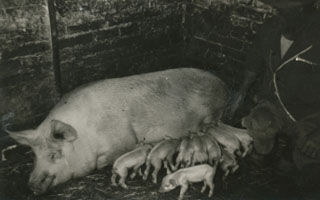The pigpen and pig raising

The pigpen, together with the bread oven and henhouse, was part of a small building in the farmyard that opened into a fenced area to allow the animals to roam outside. Each year, farming families would raise one or two pigs (ninén) for their own use. Piglets were purchased when weaned at two months of age. Families would also keep a sow (tróia, purzèla, vèra) and sell her one or two annual litters (ninazén) after weaning and castration by a pork butcher (castrén). Pigs were fed two or three times a day with a mash (pastòn, bróda) of bran and barley flour moistened with dishwater. First thing in the morning or toward evening, the children were tasked with taking the pigs out of the pen to roam in the fields and feed on wheat stubble. The fattening phase began three months prior to butchering during which flour, potato rinds, apple cores and acorns were added to the feed. Pigs reached butchering weight in December. Families who raised more than one pig would slaughter the largest prior to Christmas and the others in January and February.
Families turned to local experts among their neighbors for butchering. The animal was slaughtered with a knife and cleaned of its coarse hair with boiling water and a scraper. It was hung from its hind legs on a tripod (tripì) and emptied of its internal organs and intestine, the latter of which was used for stuffed meats such as salami, sausage and cotechino. The meat was butchered in the kitchen the following day. Various cuts were salted (thighs, shoulders, belly, loin, throat, ribs, fat, etc,), others were selected for the meat grinder (màchina da masnèr). After mixing with salt and spices, the ground pork was used to fill the intestine using a specialized utensil for meat stuffing (màchina da imbudlèr). Intestinal and other fat pieces were boiled to make pork rinds and lard; the head was cooked to separate off the meat, which was then mixed with salt, pepper and nutmeg to make a salami called coppa di testa. Salting was done in the granary, where cuts were positioned on a large wooden rack (saladòura) or a carved-out tree trunk (cònca). The meat was rubbed energetically with salt and then covered again with additional salt, pepper and crushed garlic. This process was repeated several times and concluded with the washing and drying of the pork.